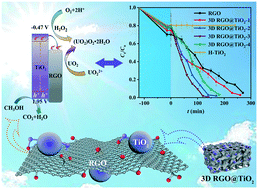3D structure aerogels constructed by reduced graphene oxide and hollow TiO2 spheres for efficient visible-light-driven photoreduction of U(vi) in air-equilibrated wastewater†
Abstract
Photocatalysis-assisted transition of uranium from the soluble U(VI) to the insoluble U(IV) is an efficient strategy for eliminating uranium. Herein, a novel 3D structure composite aerogel (3D RGO@TiO2) was applied to photoreduction of U(VI) under visible light. The introduction of RGO could expand the light absorption region and facilitate efficient charge separation of 3D RGO@TiO2. Therefore, 3D RGO@TiO2-3 (where the mass ratio of GO and H-TiO2 was 1 : 1) achieved the greatest U(VI) reduction rate (0.03752 min−1) that is almost five times higher than that of RGO. Meanwhile, the reaction between photogenerated electrons and superoxide radicals ˙O2− played the dominant role in reducing U(VI) to (UO2)O2·2H2O in air-equilibrated wastewater. This study not only provides new insights into remediation of the radioactive environment but also proves the application prospect of the 3D RGO@TiO2 in the photocatalytic field.

- This article is part of the themed collection: Environmental Remediation


 Please wait while we load your content...
Please wait while we load your content...